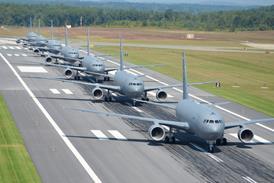PAUL LEWIS / WASHINGTON DC
Key to bringing forward in-service date of new fighter will be development of Pratt and Whitney powerplant
Development and testing of the Pratt and Whitney JSF119 powerplant is emerging as the critical pacing item for the Joint Strike Fighter (JSF), in response to an unofficial study considering the possible acceleration of the programme to avoid costly life-extensions for current fighters.
The schedule calls for initial JSF Block 1 deliveries to the US Marine Corps in 2008, with an initial operational capability (IOC) targeted for 2010. The US Air Force IOC for the conventional take-off JSF is set for September 2011, with the US Navy carrier version a year later. Some within these services are interested in accelerating this timetable by up to a year.
Industry sources say the critical date will be first flight of the Preferred Weapons System Concept, or full-scale development prototype, planned for 48 months after engineering and manufacturing development (EMD) begins. The JSF programme office (JPO) plans to announce the programme winner later this month and award a contract on 1 November.
Advancing first flight would hinge on how quickly JSF119 testing could begin so that qualification is complete. Measures have already been taken that could allow the JPO to shave up to six months from the schedule. This has included ordering long-lead items, such as engine castings and forgings, ahead of the start of EMD. The four JSF concept demonstrator aircraft built by Boeing and Lockheed Martin with the respective JSF119-614 and -611 engines have been preserved and could be added to the EMD effort in November.
Industry sources suggest that 12 months could be cut from the EMD schedule without adding significant risk, but the decider will be funding availability.
The final JSF winner decision will rest with the source selection authority, which rotates between the services.
Source: Flight International























